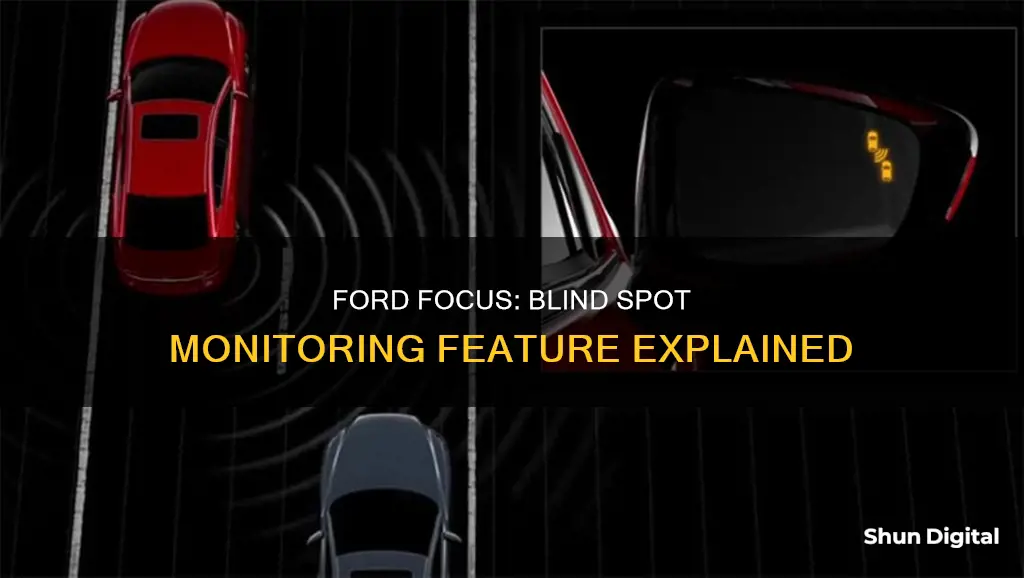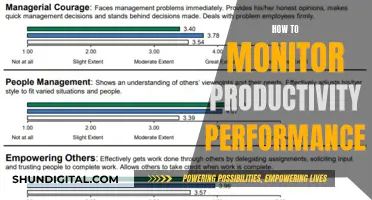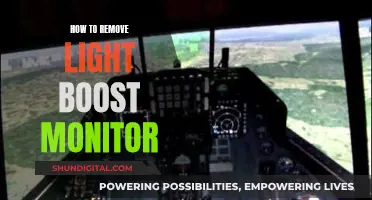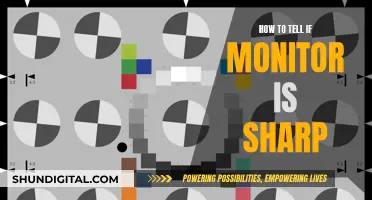
Blind-spot monitoring is a crucial feature for drivers who want to enhance their safety on the road. While changing lanes or backing out of a parking space, it's essential to be aware of vehicles or obstacles that might be in your blind spot. This is where the iBeam® Blind Spot Detection Kit, Echomaster® Blind Spot Camera, and other similar products come into play. They are designed to help drivers of Ford Focus vehicles increase their safety and confidence while driving and parking. So, does the Ford Focus come with blind-spot monitoring? Let's delve into this topic and explore the available options and considerations for enhancing your driving experience.
What You'll Learn

Ford Focus blind spot monitoring: radar sensors and how they work
The Ford Focus is available with blind-spot monitoring as part of the Ford Co-Pilot360 suite of safety features. This includes automatic emergency braking, lane-keeping assistance, automatic high beams, and a rearview camera.
The Blind Spot Information System (BLIS) uses radar sensors located behind the rear bumper fascia on each side of the vehicle. The detection area extends from the exterior mirrors to about 10 feet beyond the bumper on both sides. When a vehicle enters the driver's blind spot, the system is triggered, and a yellow alert indicator illuminates on the corresponding exterior mirror.
When the driver shifts into reverse, BLIS deactivates and the system enters Cross Traffic Alert mode. This mode uses the same radar sensors to detect approaching vehicles up to 45 feet away when backing up. When triggered, the system illuminates a yellow alert indicator on the corresponding exterior mirror, displays a warning message on the driver's information display, and sounds a series of tones.
The radar technology used in the Ford Focus's blind-spot monitoring system is designed to detect vehicles in the driver's blind spot and provide alerts to help with lane changes and backing out of parking spaces. The radar sensors continuously scan the areas beside and behind the vehicle, ensuring that the driver is aware of potential hazards.
Easy Ways to Find Your Monitor's Frame Rate
You may want to see also

Ford Co-Pilot360: what is included in the suite
The Ford Co-Pilot360™ is a suite of driver-assistance features that helps you drive more safely and confidently. The system includes:
Pre-Collision Assist with Automatic Emergency Braking
Pre-Collision Assist scans the road ahead and alerts you to potential collisions with vehicles or pedestrians. If you don't take corrective action, Automatic Emergency Braking can brake for you if necessary.
BLIS® (Blind Spot Information System) with Cross-Traffic Alert
BLIS® uses radar sensors on both sides near the rear of the vehicle to detect vehicles in your blind spot. When a vehicle is detected, you are alerted with an indicator light in the side-view mirror. The Cross-Traffic Alert feature uses radar to detect traffic behind your vehicle when reversing. It flashes an indicator light in the side-view mirrors and emits an audible warning.
Lane-Keeping System
The Lane-Keeping System uses a camera to monitor lane markings and detect unintentional drifting. Depending on the driver-selected mode, the system can warn the driver with a steering wheel vibration or apply steering torque to centre the vehicle in its lane.
Auto High-Beam Headlamps
Auto High-Beam Headlamps can sense oncoming headlights and dim automatically, providing visibility without blinding other drivers.
Ford Co-Pilot360 Assist+
Ford also offers premium driver-assist technologies, including Adaptive Cruise Control with Stop & Go and Lane Centering, Evasive Steering Assist, and Post-collision Braking.
Monitoring Vyve Data Usage: A Comprehensive Guide
You may want to see also

Blind spot monitoring: how to install it in your Ford Focus
Blind spots can be dangerous, but thankfully, blind spot monitoring systems can help alert you of potential hazards that you might not be able to see. While some Ford Focus models may come with a built-in blind spot monitoring system, you can also install an aftermarket blind spot monitor. Here's a step-by-step guide on how to install one in your Ford Focus:
Step 1: Prepare the Calibration
Place the measuring tape parallel to your Ford Focus's wheels. Take out the calibration cloth from your blind spot monitoring system kit and place it behind the vehicle, aligning it with the measuring tape at a 90-degree angle. Use a level to create a vertical line against the vehicle, which should also align with the calibration cloth. Mark a straight line on the rear bumper with a marker.
Step 2: Remove Rear Bumper and Clean
Remove the rear bumper of your Ford Focus. You may also need to remove the taillights. Clean the calibrating positions in the inner rear bumper with a cleaning cloth and rubbing alcohol.
Step 3: Place the Magnets
Obtain the two magnets that came with your kit. Place one magnet on the outside of the vehicle, along the line you marked in Step 1. Place the other magnet inside the vehicle so that they attract each other. Play around with the placement of the sensors to find the optimal angle, which should be around 20 degrees from the bumper. Mark the spot inside the bumper where the magnet rests.
Step 4: Install the Sensors
Apply adhesive to the sensors and stick them to the marked spots inside the bumper. Ensure they are firmly attached.
Step 5: Mount the LED Indicators
Mount the LED indicators inside the cabin of your Ford Focus. Place them in a location that is easily visible without obstructing your view of the road. Refer to your kit's recommendations for the best placement.
Step 6: Adjust the Volume and Test
Adjust the volume of the indicator to ensure it is at a suitable level. Test the system to verify that it is functioning correctly and that you are not startled by the alert.
Final Thoughts:
If you have any questions or encounter any difficulties during the installation process, don't hesitate to reach out to a professional service center for assistance. While you can install an aftermarket blind spot monitor yourself, it is recommended to seek professional installation for the best results. Remember, blind spot monitoring systems are a helpful addition, but they do not replace the need for cautious driving and mirror usage.
Identifying G-Sync in Monitors: A Quick Guide to Look For
You may want to see also

Ford Focus: the difference between blind spot mirrors and BLIS
The Ford Focus is available with blind spot monitoring as part of the Ford Co-Pilot360 suite of driver-assistance features. This includes a Blind Spot Information System (BLIS) with Cross-Traffic Alert, which can help you change lanes or back out of a parking space with more confidence.
Blind Spot Mirrors vs BLIS
Blind Spot Mirrors are a simple yet effective technology to improve road safety. They are curved mirrors that attach to your existing side mirrors, providing a wider field of view and helping to eliminate blind spots. These mirrors are a low-cost option and can be easily installed on most vehicles. They are especially useful when towing or driving in busy urban areas.
BLIS, on the other hand, is a more advanced technology that uses radar sensors on both sides of the vehicle to detect objects in the blind spot. When the system detects a vehicle, it alerts the driver with an indicator light in the side-view mirror, a warning message on the dashboard, and an audible tone. BLIS also includes Cross-Traffic Alert, which uses radar to detect traffic when reversing out of a parking space or driveway. This feature provides both visual and audible alerts to warn the driver of approaching vehicles from the sides.
One of the key advantages of BLIS over traditional blind-spot mirrors is its ability to detect objects beyond the driver's field of view. While blind-spot mirrors can help expand the driver's visibility, BLIS provides an extra layer of safety by using sensors to detect objects that may be outside the mirror's range or in the vehicle's blind spot. Additionally, BLIS offers a more immediate alert system, with visual and audible warnings, ensuring that the driver is promptly notified of potential hazards.
In summary, while both blind-spot mirrors and BLIS aim to improve safety by reducing blind spots, BLIS offers a more comprehensive and automated solution by utilising advanced sensor technology and multiple alert options. Blind-spot mirrors, however, offer a more cost-effective and simple solution for drivers who may not require the additional features of BLIS. Ultimately, both options provide valuable assistance to drivers, helping to enhance safety and situational awareness on the road.
Understanding the HDMI Cable on Your ASUS Monitor
You may want to see also

Ford Focus: other safety features
The Ford Focus is offered with a variety of safety features, including blind-spot monitoring. This system, known as BLIS (Blind Spot Information System), uses radar sensors on both sides of the vehicle to detect objects in the driver's blind spot. When an object is detected, the driver is alerted through an indicator light in the side-view mirror, an audible warning, and a visual display in the message centre.
In addition to blind-spot monitoring, the Ford Focus also offers a Lane-Keeping System, which helps drivers stay centred in their lane. This system uses a camera mounted behind the rearview mirror to monitor lane markings and detect unintentional drifting. Depending on the driver's selected mode, the system can warn the driver with a steering wheel vibration or apply steering torque to direct the vehicle back to the centre of the lane.
Other safety features available on the Ford Focus include automatic emergency braking, rear cross-traffic alert, and a rearview camera. The rear cross-traffic alert uses the same radar sensors as the BLIS system to detect traffic when backing up, providing both visual and audible warnings. The Ford Focus also offers automatic high beams, which can be particularly useful when driving at night or in low-visibility conditions.
Furthermore, the Ford Focus may also be equipped with additional safety features, such as a rear parking camera, front and rear parking sensors, and advanced driver-assist systems. These features contribute to a safer driving experience, providing drivers with assistance and warnings to help prevent accidents and improve overall driving confidence.
Recognizing a CRT Monitor's Demise: Signs to Look For
You may want to see also
Frequently asked questions
Yes, the Ford Focus does offer blind-spot monitoring as an optional feature.
Blind-spot monitoring, or the Blind Spot Information System (BLIS), helps detect vehicles in the driver's blind spot. It uses radar sensors on both sides of the vehicle and alerts the driver with an indicator light in the side-view mirror when a vehicle is detected.
Blind-spot monitoring can be installed in a Ford Focus by purchasing a Blind Spot Detection Kit, which is available from third-party suppliers.
The Ford Co-Pilot360 suite includes five standard safety features: automatic emergency braking, lane-keeping assistance, blind-spot monitoring, automatic high beams, and a rearview camera.
BLIS alerts the driver when a vehicle enters their blind spot zone, while Cross-Traffic Alert warns of traffic approaching from the sides when the vehicle is in reverse.







